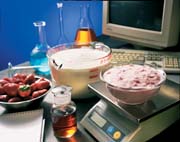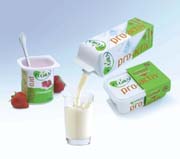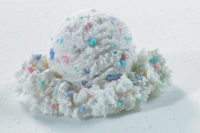
Of course, cows milk is one of the most nutritious foods available to humans. And, it sure tastes good, which is why it is an attractive vehicle to provide consumers with additional better-for-you ingredients, ingredients that go above and beyond what milk already inherently contains.
"Healthy products today must deliver better taste with better nutrition at an affordable price. It is no longer an either/or proposition for shoppers," according to Linda Gilbert, pres., HealthFocus International, St. Petersburg, Fla. "Brands can differentiate themselves to capture brand and category share through better nutrition, but shoppers will only buy again if the brand delivers on taste and value."
According to the hot-off-the-presses 2003 HealthFocus Trend Report, shoppers' attitudes about the importance of taking nutritional supplements have changed dramatically in recent years. Sixty-eight percent of shoppers strongly agree or agree that it is important to take a vitamin and/or mineral supplement every day, which is up 19 points from 49% in 1994. However, at the same time, more than nine in 10 shoppers believe that it is important to eat foods that are naturally rich sources of key vitamins and minerals, a figure that has remained relatively constant since 1996. Interestingly, more shoppers today feel it is important to eat foods fortified with added vitamins and minerals, which is up 4 points since 1996. This suggests that there is great interest among shoppers in making sure their diets are vitamin rich.
"Shoppers have resigned themselves to the fact that busy lifestyles and fragmented eating habits mean they can't count on getting all the nutrition they need from three meals a day any longer," Gilbert says. "Fortified foods and beverages, and supplements help to fill their nutritional gaps."

Milk first with vitamin D
When it comes to fortification, milk, in fact, was one of the first foods to be fortified, and this was to prevent rickets, which is a bone debilitating disease that weakens and deforms the skeletal system. When the connection between vitamin D and rickets was first made many years ago, it was in the 1930's that experts agreed milk was an ideal vehicle for fortification in order to ensure that everyone, particularly children, received adequate levels of this vitamin, as at the time "everyone drank milk."For years, a few glasses of milk were considered enough of a vitamin D fix for most people. However, that is beginning to change now that vitamin D deficiency is largely to blame for the recent return of rickets among U.S. infants and toddlers, according to the Federal Centers for Disease Control and Prevention.
Why is rickets once again a concern? Well, part of the answer lies in the fact that not everyone drinks milk anymore, and even many of those who do drink milk, are not consuming enough to receive adequate levels of vitamin D. Furthermore, vitamin D, which is synthesized in the skin when it's exposed to sunlight (ultraviolet rays), is not being made in ample supplies thanks to increased use of sunscreen, as sunscreens with a sun protection factor of 8 or greater block the ultraviolet rays that produce vitamin D. This doesn't mean consumers should stop using sunscreen, but it is important that individuals with limited sun exposure include good sources of vitamin D in their diet.
Vitamin D prevents rickets because it aids in the absorption of calcium, which is necessary to form and maintain strong bones. This means that insufficient vitamin D can also set the stage for osteoporosis. Vitamin D has also been linked to preventing cancer, multiple sclerosis, diabetes and high blood pressure.
How serious is the vitamin D deficiency issue? According to a three-year study funded by the Maine Dairy and Nutrition Council, insufficient levels of vitamin D were detected in nearly half of 24 Bangor, Maine-area girls. Vitamin D deficiency is most common in post-menopausal women and older Americans. However, intake is critical for children because they add calcium to their bones at a fast pace, maintain those levels into adulthood then start to lose calcium as they grow elderly. Therefore, children need to get enough vitamin D early on in order to optimize their bone calcium.
For people under 50, the Institutes of Medicine set 200 international units of vitamin D as the adequate daily allowance, the equivalent of two 8-oz glasses of vitamin D-fortified milk.
Susan Sullivan, assistant professor of human nutrition at the University of Maine, where the study was conducted, suggests three glasses of milk for adults and four for teenagers. Other vitamin D experts recommend as much as 1,000 international units as the standard, which is about 10 glasses of milk. Oddly, this happens to be the upper limit of safety for vitamin D according to the Institutes of Medicine.
The current Daily Value for vitamin D is 400 IU. (The Daily Value is the number used to compute the percentages on the Nutrition Facts label on packaged foods.) Current recommendations also say that after age 70, consumers should get 600 IU per day. This is because older Americans are believed to have a higher risk of developing vitamin D deficiency due to the decreased ability of the skin to convert vitamin D to its active form. (This looks like an opportunity for a functional dairy-based beverage fortified with vitamin D targeted to Baby Boomers!)
Besides milk, cheese is another potential vehicle for vitamin D. Researchers at the Western Dairy Center, with support from Dairy Management Inc., have identified a way to add vitamin D to cheese by using high-pressure injection technology. The result is vitamin-fortified cheese that tastes just like regular cheese.
Carl Brothersen, associate director of the Western Dairy Center and Utah State University researcher who developed the cheese injection method has explored the injection of vitamins D, B6 and folic acid in liquid form into Cheddar and mozzarella cheeses. Injecting the cheeses and testing them after a 330-day aging period, Brothersen found the vitamins did not markedly affect the ripening process or flavor of the cheeses.
"A trained taste panel did not detect any significant difference in flavor between the fortified and regular cheeses," he says. Furthermore, the cheese microflora did not eliminate the vitamins. "We were concerned the starter cultures and non-starter cultures might consume the vitamins, but that didn't happen to the extent we thought it would." At the end of the 330-day period, the highest vitamin loss was the folic acid (40%) in mozzarella and the lowest loss was Vitamin D (0%) in mozzarella.
A cheesemaker interested in this technology would want to look further into "all vitamins at different time intervals to quantify any loss during ripening," he says.
For more information on this technology, call Dairy Management Inc. at 800/248-8829.

Dairy for lowering cholesterol
Another hot fortifying-ingredient is phytosterol. Phytosterols, along with plant sterols, are natural compounds derived from plants that are recognized for reducing blood cholesterol. These sterol ingredients help lower blood cholesterol because they are structurally similar to cholesterol, and consequently, compete with ingested cholesterol for absorption through the small intestine. In essence, the more sterols present in the gastrointestinal tract following a meal, the less likely cholesterol absorption will occur. Interestingly, the sterols themselves are not absorbed to any appreciable extent. They simply block cholesterol absorption and get flushed through the intestines.Lifeline Food Co., Seaside, Calif., was the first, and so far the only dairy marketer to offer U.S. consumers a dairy product containing phytosterols. However, sterols are showing up in many other foods including orange juice and soymilk.
The Lifetime® Low Fat Cheeses from Lifeline Food are fortified specifically with phytosterol esters. A single 1-oz serving of the cheese, which comes in Cheddar, extra sharp Cheddar, jalapeño Jack and mozzarella, contains 0.65g phytosterols. A serving at two meals provides the recommended amount to reap the cholesterol-lowering benefits of phytosterols.
"When developing the cheeses, in order to make the ‘reducing cholesterol' claim, there could be no more than 1g of saturated fat in the cheese," explains Jone Chappell, pres. "The low-fat product fit the bill, and after several trials, we decided to add the phytosterols to our low-fat pasteurized product.
"As far as taste, the cheeses with phytosterols actually taste creamier than the regular low-fat product because the phytosterol esters act as a fat mimetic," Chappell adds.
In the United Kingdom, Flora has recently rolled out a line of dairy foods fortified with plant sterols. Flora Pro.Activ milk drink is the first milk drink to contain plant sterols. It comes in 1 liter cartons and is sold chilled, right along with traditional milk. Flora Pro.Activ low-fat yogurts come in a pack of four strawberry yogurts or a mixed four-pack comprising strawberry, raspberry, cherry and apricot flavors.
Three servings a day of any Flora Pro.Activ product, combined with a healthful diet, have been clinically proven to reduce low-density lipoprotein (LDL) cholesterol-the bad cholesterol-by 10% to 15% within three weeks of starting the three-a-day regime.

Soluble, bioavailable iron
The last fortifying ingredient to be addressed is iron, an element vital to life. This is because iron is responsible for transporting oxygen into cells and carbon dioxide out of cells, making iron indirectly essential for energy metabolism, which is why people with low iron diets tend to be fatigued. The amount of iron in the human body is very small, a mere 3-5g, but again, that little bit is very important.Daily dietary requirements for iron vary by individual and are affected by factors such as growth periods for kids and menstrual cycles and pregnancy for women. The National Academy of Sciences set the Recommended Dietary Allowance for men and post-menopausal women at 8mg a day and at 18mg for pre-menopausal women. For pregnant women, it is 27mg, and for those breast-feeding and not menstruating, it is 9mg.
Because the average U.S. daily diet contains 12-15mg of iron, to prevent iron deficiency in high-need population segments, doctors often recommend iron supplements. Interestingly, those consumers requiring more iron are the same population segment that needs more calcium. This presents dairy foods manufacturers with an incredible opportunity to add value to their products through iron fortification.
Unfortunately, many iron sources that exhibit the best bioavailability, such as ferrous sulfate, adversely affect food and beverage quality by accelerating lipid oxidation, producing unfavorable color or flavor and causing severe irritation of the gastrointestinal system. Compatible and non-reactive iron compounds are needed for fortification of foods as they have less of an "iron taste" compared to soluble iron. However, due to insolubility issues, precipitation of such iron ingredients prevents fortification in large amounts, until now.

The super-dispersion technology also masks any disagreeable iron flavors without affecting the flavor of the final product. When dispersed in water, this iron ingredient creates a clear to slightly milky white solution, not the usual brownish color of most other iron fortifying ingredients. It is stable against heat, salt, pH and oxidation, and is mild on the gastrointestinal system, providing a non-irritating iron fortification with superior absorption properties and bioavailability.
Product developers in Japan and Europe are using this iron ingredient to fortify an array of dairy foods including milk and yogurt, as well as sports drinks. Such products generally contain about 1mg of iron per serving.
Maeil Dairy Industry Co., Seoul, Korea, manufactures a line of iron-fortified milks targeted to very small children, who need large amounts of iron for proper growth and development. The First Milk variety contains 0.37mg/100ml, and the Growth Milk variety contains 0.42mg/100ml. This is 3-4 times the amount of iron in regular milk in Korea, which has 0.1 mg/100ml.
In time, this fortifying trend is sure to catch on in the United States, particularly as consumers continue their quest for health and wellness.
To fortify or not? That is the question.
